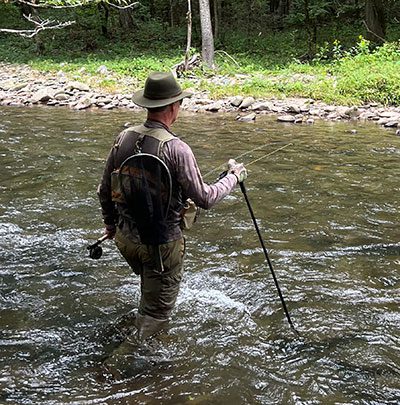I think a lot when I’m on the stream. Probably too much, but my mind is always going. Mostly, I try to incorporate that activity into my problem-solving skills to catch the next trout. Quite often, approaching a likely pool or run is the next problem to solve, requiring an approach to best fish the water without spooking the fish. Often, that means wading through fast water over slippery underwater rocks of various sizes and shapes.
In the past few years, having not one but two-foot surgeries, my aforementioned skills have led me to a greater use of a wading staff. I’ve had one for many years, mostly using it for tailwaters as you never know about those generation schedules. Occasionally, I have used a wading staff when the water was running high in the local freestone streams. More than once it has kept me from getting stuck on the wrong side of the river when a cloudburst creates a sudden rise in the water flow which can change as quickly as two generators from one of the nearby dams.
Following the first and unsuccessful surgery on my foot in 2020, my first trip included hooking a nice, fat brown. The water was flowing good, and my foot was yet to be tested on the ever punishing and unpredictably slick creek bottom. Fortunately, I had taken my dusty wading staff. When the brown started its run downstream in the high, springtime water I thought, “Showtime…. This is gonna hurt!” And it did. It’s amazing some of the things we’ll do for fish, “Damn the foot, full speed downstream!” After I landed the sixteen-inch brown, not a bad one for this stretch of water, I sat for a while as the throbbing pain reminded me what the foot had been through just a few months earlier.
Later that summer, I was fishing the Microburst section on Rock Creek just outside of Missoula, Montana. If you know much about Rock Creek, it’s called the “fifty-mile riffle” for a reason. Seeing no holding areas for trout in the constant flow, I walked out to the middle of the fast moving, knee-deep water. Without my trusty staff, there was absolutely NO WAY I could have made it. I eyeballed the amount of line needed to reach the small two foot wide strip of slack water along the far bank. Bracing myself with my left hand on the staff, I made a right-handed cast of my Jumpin Jack Flash. As the adjacent current pulled the fly out of the slack water and into the current a nice brown trout slammed it! This happened time and again. I think that was the moment I got “hooked” on the wading staff.
The first surgery failed so after my second foot surgery, all the result of a broken foot from wading the same streams about fifteen years earlier, my altered and rebuilt “bionic” foot had lost roughly twenty percent of its overall contribution to my balance.
“Remember, Stevie. Every rock is out to get you and make you fall. It’s the sole purpose of why they’re in the creek, for you to bang your shins and bust yer butt on!” Dillon, in Tails of the Smokies.
I realized that day that by using the wading staff on Rock Creek it gave me a third contact point of balance, enabling me to reach otherwise inaccessible areas that are less frequently fished and the ability to do so more safely. I’ve also learned the staff is also good for checking water depth. I’ve marked a spot on my staff representing my knee-deep level, for reference. More than once, I’ve questioned the next step only to find what I call my “I don’t think so” depth and wisely took the long way around.
I’ve now included my wading staff as an integral part of my wading gear, right behind a good pair of boots. Newly acquired uses have included poking around for snakes in the woods, even pole vaulting across a difficult jump! On a recent trip, I loaned it to a friend as we fished some fast flowing pocket water on a mid-sized stream. Not only did it increase his confidence in traversing the streambed, but upon his return home his first task was purchasing a wading staff of his own!
A good aluminum wading staff can be found for around $50 and can easily fold up into a pouch attached to your belt. I like the convenience of one that when pulled out, automatically snaps into place for immediate use. Don’t forget to tether it to your belt and a good accessory is a retraction cord. With the price of most fishing equipment today, that’s a great deal for the improved safety and increased capability you will glean from its use. Though nothing, not even the best boots, are slip or fall proof, a good wading staff is well worth the small cost!
Jim Parks has spent nearly 50 years fly fishing in the Great Smoky Mountains National Park. He is a regular contributor to The Angler Magazine and gives talks on fly fishing to various clubs and civic organizations. Jim is the author of “Tails Of The Smokies”. For copies of his book, he can be reached via his Instagram page at “TailsOfTheSmokies” where you will also find his most effective patterns and other articles on fly fishing.
